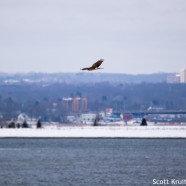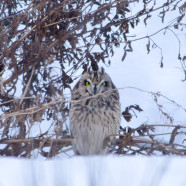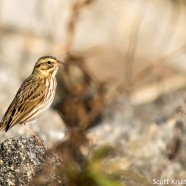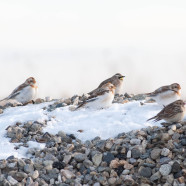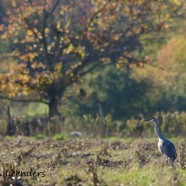Northern Harrier in the Snow and Sky
I recently photographed this Northern Harrier flying through some heavy snow. These are the most typical sort of views you will have of the species while surveying for them in the field. The long and thin raptor can often be easily identified swooping low over the land, watching for prey, by the big white patch at the base of the tail. They can be seen in grasslands, farm fields, and coastal areas. If you are one of our friends in Chautuauqa County please remember that we at the Roger Tory Peterson Institute of Natural History are assisting the New York State Department of Environmental...
Read MoreFind Winter Raptors in Chautauqua County
If you are one of our friends in Chautuauqa County please remember that we at the Roger Tory Peterson Institute of Natural History are assisting the New York State Department of Environmental Conservation for a second season of wintering raptor surveys in 2014-2015 and need your continuing help! The primary focus of these surveys is to determine where Short-eared Owls (Asio flammeus), ‘endangered’ in New York, and Northern Harriers (Circus cyaneus), ‘threatened’ in New York, are spending the winter season to roost and feed. Western New York’s NYSDEC Region 9 is a large geographical area and...
Read MoreSavannah Sparrow (Passerculus sandwichensis)
Here we have an attentive Savannah Sparrow (Passerculus sandwichensis), a winter landbird species that you should be on the lookout for mixed in with other sparrows. They can be found especially near any farmlands, fields, grasslands and coastal areas, looking for seeds to devour. If there is a snowfall you can find them seeking out areas near water or plowed habitat that provides unexpectedly helpful access to grasses. This is a more typical Savannah Sparrow, but if you live on the Atlantic Coast be mindful of finding the large, pale “Ipswich” Savannah Sparrow on beaches and...
Read MoreIdentify these three winter species
Can you identify all the wintering birds in this photo? There are five individuals of three species here. They do enjoy hanging out with one another and this year it seems plenty of people have been lucky enough to spot them together in various parts of the northeast. They all enjoy open areas like grasslands, farms, beaches, roadsides and fields. The answers will be listed after this photo so don’t cheat! Do you have them all? If not look away now! The birds are, from left to right, a Snow Bunting (Plectrophenax nivalis), another Snow Bunting with a Horned Lark (Eremophila alpestris)...
Read MoreSandhill Crane (Grus canadensis) by Twan Leenders
Early in the afternoon of November 21 Twan and I took a couple of minutes to go outside at RTPI and move our dumpster. Exciting, I know. As we finished I looked up, as I always do instinctively, for anything flying over and said “What is that..?” incredulously at the non-raptor drifting over us heading west. “That” was a Sandhill Crane. Naturally we did not have binoculars or cameras on us which is particularly rare for me because I hate ending up in these situations. The birds know when you’re unprepared. Here’s a shot of a Sandhill Crane that Twan took...
Read More



